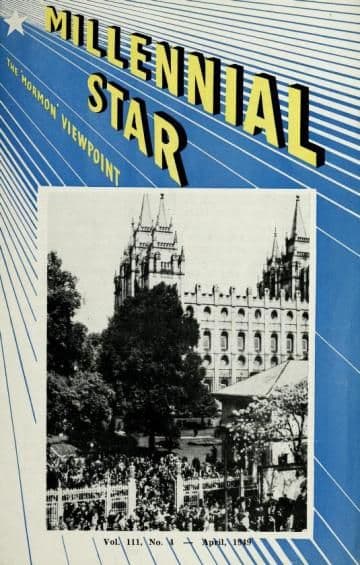Magazine
Urim and Thummim (April 1949)

Title
Urim and Thummim (April 1949)
Magazine
The Latter-Day Saints' Millennial Star
Publication Type
Magazine Article
Year of Publication
1949
Authors
Sonne, Alma (Primary)
Number of Pages
101, 127
Date Published
April 1949
Volume
111
Issue Number
4
Abstract
This article states that prophets of old used the Urim and Thummim. The claims made by Joseph Smith were not illogical. King Saul used the devices as well as Moses and others. Joseph Smith’s account of using them is not out of harmony with these accounts. They are defined as “lights” and “perfections.”
URIM AND THUMMIM
Alma Sonne
European Mission President and Assistant to the Council of the Twelve
THE Urim and Thummim have always been associated with the coming forth of the Book of Mormon. Many questions concerning these sacred instruments are presented to the missionaries in the field. It is known that they were aids to the Prophet Joseph Smith in his work of translation and in receiving revelations from God. It was not until the Prophet announced his possession of them, however, that their real purpose and use became generally known. While their spiritual significance and the manner in which they functioned have not been fully explained, it can be truthfully said that the claims made for them by Joseph Smith, the Prophet, were neither unscriptural, illogical nor without precedent. The Prophets of the past who acted as oracles of God had access to them and were divinely prompted and directed by them in their prophetic callings.
When Israel was face to face with one of her great crises, Saul, the King of Israel, had tried every legitimate means to obtain divine knowledge and guidance: “And when Saul inquired of the Lord, the Lord answered him not, neither by dreams, nor by Urim, nor by the prophets.” (I Sam. 28: 6) The Urim and Thummim, ordinarily consulted by the prophets, would yield no information to Saul because he had departed from the Lord. He had lost divine guidance through disobedience. It is important to know, however, that at this stage in the history of Israel one of the mediums through which God communicated His mind and will was the Urim and Thummim.
From the tribe of Levi were chosen the priests upon whom sacred, religious responsibilities rested. It is interesting to observe that Moses in blessing this tribe said, “Let thy Urim and Thummim be with thy holy one.” (I Sam. 28: 5) Again, when Moses put the breastplate upon Aaron, the Levite Priest, he used the following significant words, “put in the breastplate the Urim and Thummim.” (Leviticus 8:8) In the instructions of the Lord to Aaron through the Prophet Moses we read, “And thou shalt put in the breastplate of judgment the Urim and Thummim; and they shall be upon Aaron’s heart, when he goeth in before the Lord; and Aaron shall bear the judgment of the Children of Israel upon his head before the Lord continually.” (Exodus 28: 30) The last reference in the Old Testament to these holy symbols is found in the account of Israel’s return from their Babylonian captivity, “And the Tirshatha said unto them, that they should not eat of the most holy things, till there stood up a priest with Urim and Thummim.” (Nehemiah 7: 65) The above references clearly indicate that the Urim and Thummim were in use among the Israelites during the period when they were led and directed by revelations through the prophets.
It is not unreasonable to believe that a modern prophet should be similarly favoured and aided in his interpretation of the Lord’s will to humanity. Nor is it reasonable to assume that these instruments had served their full purpose with the passing of the prophets to whom they had been entrusted. Joseph Smith received the Urim and Thummim from the Angel Moroni. They were given to him in connection with the plates from which the Book of Mormon was translated and were described by him as “two stones in silver bows—fastened to a breastplate.” This description, together with his explanation of their use, is not out of harmony with the meagre information given in the Bible concerning them. Is it not additional evidence to support the divinity of his prophetic calling?
Hebrew scholars have defined Urim and Thummim to mean “lights” and “perfections” respectively. In July, 1838, in the Elder’s Journal published in Far West, Missouri, the Prophet said: “Moroni, the person who deposited the plates from which the Book of Mormon was translated, in a hill in Manchester, Ontario County, New York, being dead, and raised again therefrom, appeared unto me, and told me where they were; and gave me directions how to obtain them. I obtained them and the Urim and Thummim with them, by the means of which I translated the plates and thus came the Book of Mormon.”
President Brigham Young, his successor, and for many years his friend and associate, said, “this earth will become a celestial body—like a sea of glass, or like a Urim and Thummim.” . Further information concerning these ancient symbols is contained in the Book of Mormon where reference is made to Mosiah’s work of translation: “And now he translated them by the means of those two stones which were fastened into the two rims of a bow. Now these things were prepared from the beginning, and were handed down from generation to generation, for the purpose of interpreting languages; and they have been kept and preserved by the hand of the Lord.” (Mosiah 28: 13-15)
Subject Keywords
Bibliographic Citation
Terms of use
Items in the BMC Archive are made publicly available for non-commercial, private use. Inclusion within the BMC Archive does not imply endorsement. Items do not represent the official views of The Church of Jesus Christ of Latter-day Saints or of Book of Mormon Central.